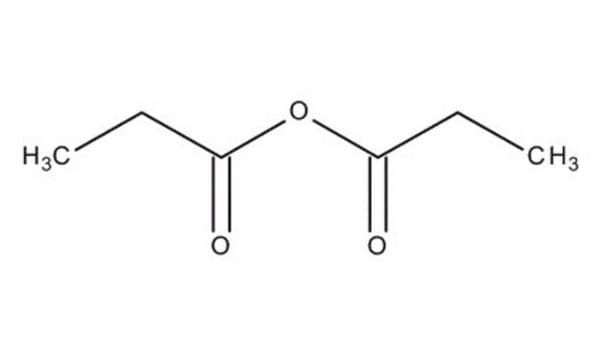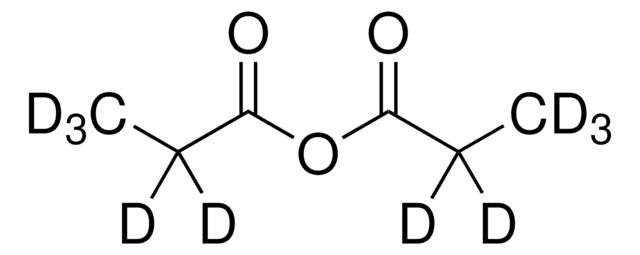240311
Propionic anhydride
≥99%
Sinónimos:
Propanoic anhydride
About This Item
Productos recomendados
vapor density
4.5 (vs air)
vapor pressure
10 mmHg ( 57.7 °C)
assay
≥99%
form
liquid
autoignition temp.
545 °F
expl. lim.
11.9 %
refractive index
n20/D 1.404 (lit.)
bp
167 °C (lit.)
mp
−43 °C (lit.)
solubility
chloroform: soluble(lit.)
diethyl ether: soluble(lit.)
ethanol: soluble(lit.)
methanol: soluble(lit.)
density
1.015 g/mL at 25 °C (lit.)
functional group
anhydride
SMILES string
CCC(=O)OC(=O)CC
InChI
1S/C6H10O3/c1-3-5(7)9-6(8)4-2/h3-4H2,1-2H3
InChI key
WYVAMUWZEOHJOQ-UHFFFAOYSA-N
¿Está buscando productos similares? Visita Guía de comparación de productos
Categorías relacionadas
Application
signalword
Danger
hcodes
Hazard Classifications
Eye Dam. 1 - Skin Corr. 1B
Storage Class
8A - Combustible corrosive hazardous materials
wgk_germany
WGK 1
flash_point_f
165.2 °F - closed cup
flash_point_c
74 °C - closed cup
ppe
Faceshields, Gloves, Goggles, type ABEK (EN14387) respirator filter
Elija entre una de las versiones más recientes:
¿Ya tiene este producto?
Encuentre la documentación para los productos que ha comprado recientemente en la Biblioteca de documentos.
Los clientes también vieron
Nuestro equipo de científicos tiene experiencia en todas las áreas de investigación: Ciencias de la vida, Ciencia de los materiales, Síntesis química, Cromatografía, Analítica y muchas otras.
Póngase en contacto con el Servicio técnico










![(2R)-2-Phenyl-3,4-dihydro-2H-pyrimido[2,1-b][1,3]benzothiazole ≥95%](/deepweb/assets/sigmaaldrich/product/structures/302/833/59a06b8b-9e9d-4dc4-a4ed-a36ab5081792/640/59a06b8b-9e9d-4dc4-a4ed-a36ab5081792.png)
